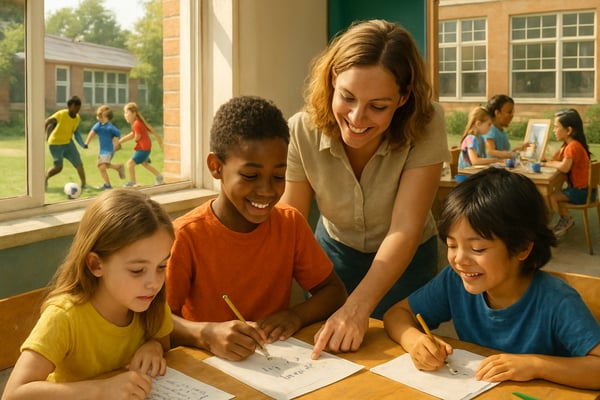The Ultimate Guide to Outdoor Learning Areas
Did you know that 92% of pupils prefer outdoor learning? Having the opportunity to get outside the classroom and interact with the great outdoors is a brilliant way to engage the mind. Although 95% of pupils also say that outside learning is more enjoyable, having the right areas to facilitate such activities is not a luxury every school has.
If you want to know how to get outdoor learning right with all safety and pupil experience considerations successfully taken into account, continue reading.
What is Outdoor Learning?
Outdoor learning is the umbrella term used to describe several activities that happen outside of the classroom on school grounds. Examples of this include sports, excursions, outdoor lessons, group tasks, arts, and curriculum play. Representing the importance of teaching lessons in different environments, schools are encouraged to think about new ways of getting students outside to further enhance their social, cognitive and physical skills.
As our list has shown, this doesn’t always mean structured lessons. Having outdoor play time is also essential for enhancing pupils’ overall experience. In fact, 88% of teachers say their students are happier after playing outside. This proves that all forms of outdoor learning can elevate indoor learning also.
What Are the Benefits of Outdoor Learning?
The advantages of outdoor learning are plentiful, with both teachers and pupils getting the opportunity to benefit from the experience. The main benefits include the following:
- Improved physical skills: Being outdoors allows students to move around more and be active. This means that balance, coordination, and agility are all improved due to outdoor learning.
- Boosting self-esteem and confidence: Being outdoors in nature is a brilliant way to encourage pupils to be curious and bold.
- Communication skills: Outdoor learning is proven to support positive development, with verbal and non-verbal communication being benefits of this. Children are encouraged to liaise with others and experience improved emotional intelligence as they are required to interact with the world around them.
- Mental health and wellbeing support: Children exposed to green space and outdoor learning are 55% less likely to develop a mental health problem. The change in scenery and associated activities are a brilliant way of improving pupil experience for the long term.
- Improved concentration: Spending 30 minutes outside can improve productivity by 45%.Working outside has also allowed students to focus more deeply on the task at hand, resulting in better grades and a deeper understanding.
- Higher academic achievements: Studies have found that students who participate in outdoor learning can achieve 27% higher on exams. Fresh air is a natural way to cleanse the mind and improve concentration. It can also help make certain complex lessons be easier to understand as it appeals to a range of pupil learning needs.
- Better school brand image: Schools that are seen to offer enhanced outdoor experiences are rated better by parents and fellow students.
How Can You Choose the Best Spaces for Outdoor Learning?
Outdoor learning can take place in any space, so it is good to get creative with the areas you have available. You can create pockets of serenity anywhere with locations next to green land being ideal. However, if this is unavailable, you still create brilliant spaces within your school grounds.
The areas you select for outdoor learning should be quiet and protected. Our school canopies allow you to create useful covered space from anywhere. Our outdoor learning pods prove you can create an engaging area in even the smallest spaces.
It is also good if you have a plan of the outdoor lessons and activities that you plan on offering as this will dictate your outdoor requirements.
What Shelters Are Needed for Outdoor Learning?
If you plan on conducting outdoor learning, you must ensure enough covered space to protect from the elements. The great British weather doesn’t always make for the nicest outdoor learning sessions, but with the right shelter, you can teach outside the classroom all year long.
You can choose from aluminium or timber canopies depending on the existing look of your school. This makes it easy to seamlessly add new areas onto the grounds from a design perspective.
Shade sails are also popular for areas with additional natural light, such as play areas. If something with more protection is what you are after, then the Spaceshade® Enclosed Canopy is a great choice.
The great thing about outdoor learning shelters is that they can be completely tailored to your needs!
Which Facilities Need To Be Considered?
Once you have decided on the type of shelter and its location, you need to plan what facilities are essential. As we have covered, outdoor learning comes in many forms. This means that every project has its own requirements that must be fulfilled.
The main facilities that you must consider when creating the ultimate outdoor learning experience for pupils are as follows:
Playground & Learning Equipment
Choosing the correct equipment is essential for tailoring the learning experience. The goal is that even when an official lesson is not taking place, some form of education is being delivered.
If you are looking for leisure time equipment, a safety-assured solution should always be selected. This could include kinesthetic toys, climbing frames, activity stations, or even freestanding items like bikes or karts. These items promote physical development and ensure that social skills are improved through interactions with other pupils.
Learning equipment for lessons can also be sourced for outdoor use as long as it is weather resistant for continued usage all year.
Playground Surfaces
Next up is the playground surface.
Safety needs to be considered, so we recommend choosing either a rubber crumb, tarmac, or bark chippings, as each is approved for use within school environments. You can also decide whether to use the same surface as the rest of your outdoor space or to add a different texture to promote new experiences for students.
It should also be remembered that the floor also offers an opportunity for education within outdoor learning, as your goal is to engage pupils in many ways. For example, when using rubber or tarmac, you can integrate markings that promote learning, such as directions, games, or maps. The possibilities are endless!
Storage
To save you time when it comes to setting up learning sessions, it is a good idea to incorporate some form of outdoor storage. This allows equipment to be safely locked away when not in use, removing risks such as theft or damage.
Access to Drinking Water and Toilet Facilities
Clear and easy access to water facilities also needs to be considered. This includes drinking water, cleaning areas, and toilet facilities. Maintaining student health and well-being is important at all times, especially when they are outdoors and susceptible to factors such as dehydration.
Sunlight & Shade
On the theme of outdoor elements, access to shade and protection from UV radiation also needs to be factored in. Whether you consider via your choice of canopy or introduce other forms of shade, this is an issue that needs to be dealt with all year round.
Does Outdoor Learning Require Landscaping or Nature Elements?
You can teach regular lessons outside, but the benefits you will receive from your new learning spaces will be enhanced with the right outdoor spaces. If you can place a learning space near a green area, you can add extra teaching themes into the curriculum. Being near trees and open spaces is also a great way to provide an immersive experience which benefits mental and physical wellbeing.
You should also consider having something interactive for pupils, such as a tree planting space or vegetable patch.
What Safety Regulations Need to Be Followed for Outdoor Learning?
The most important thing to consider is the safety of pupils.
Outdoor spaces still need to be safe and secure, with elements such as electrical areas, fencing and secure protection considered as you would with the rest of the school.
If you are considering bringing in outdoor learning, you would have likely come across the Forest School Association. The approach is based on Scandinavian teachings, offering children the chance to learn outdoors in new environments. These activities do not occur within the school grounds, so are privy to different rules and regulations.
The UK-based charity states that their purpose is as follows, “The advancement of education for public benefit through promotion and support of quality Forest School in the United Kingdom using any means to enable all children, young people and adults to benefit from increased opportunities for high quality and varied educational experiences in the natural world.”
Their approach is something that can be factored into everyday outdoor learning environments, with positive lessons such as communication and physical activity being of high importance.
When bringing outdoor learning to your school, you should align with the UK Government’s standards for school premises to ensure your space is up to standard. Our school learning canopies are built with the strictest safety standards and meet all school needs.
How Can Kensington Systems Help Me?
As you can see from our case studies, creating outdoor learning shelters which promote both structured lessons and more creative learning is something that we specialise in. From supporting the design and concepts to building a fully efficient area, we work closely with schools to enhance the pupil and teacher experience.
To learn more, contact us today.

.jpg?width=600&height=400&name=Paddock%20SEND%20School%20-%20Spaceshade%20canopies%20with%20post%20protectors%20(6).jpg)

